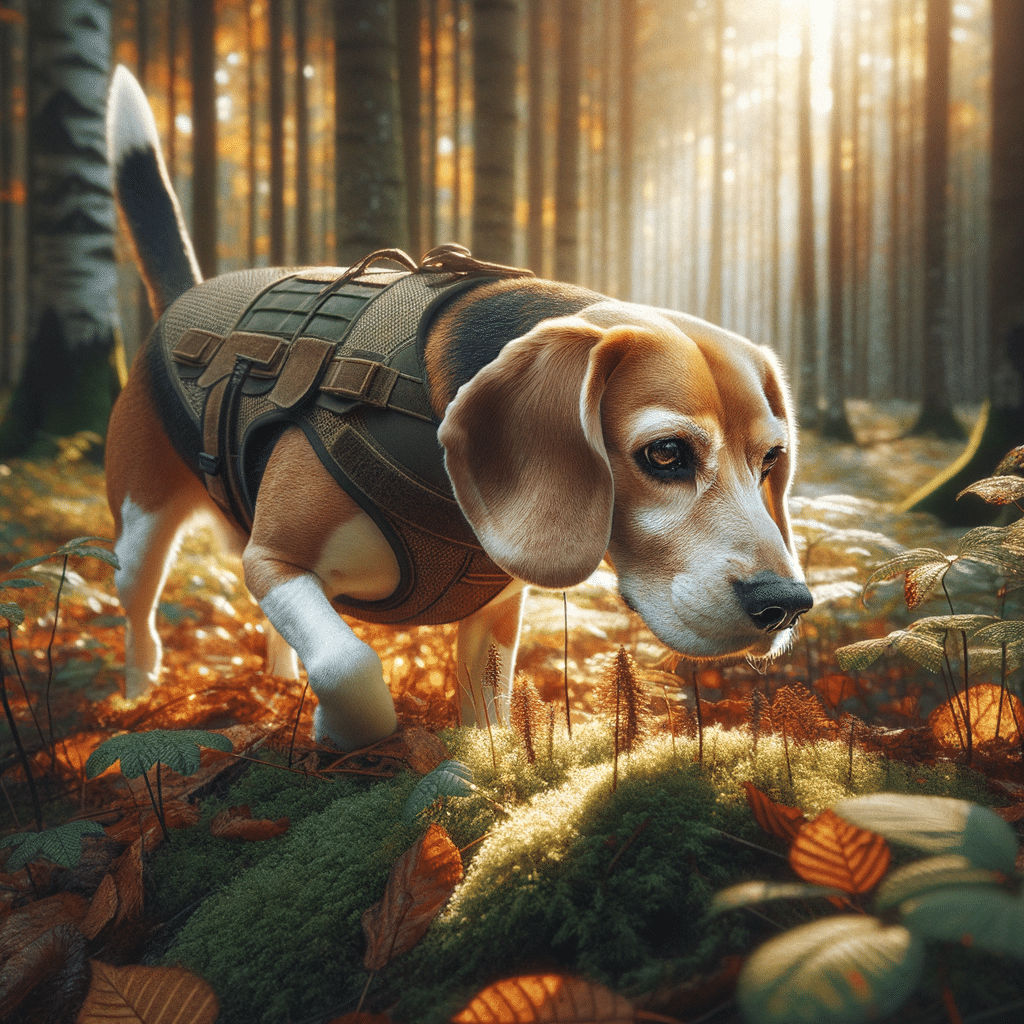When considering the addition of a beagle dog to a household with a feline member, or vice versa, the beagle breed often comes up as a top contender due to their temperament. Known for their even-tempered and amiable nature, beagles are commonly recommended as the best dog breeds for families due to their ability to get along with other pets, including cats. The compatibility of beagles with cats relies on the individual personalities of the pets and the way they are introduced to and socialized with each other.
In This Article
Beagles, originally bred as hunting dogs, are naturally friendly and lack aggression, making them suitable companions for other animals. Nonetheless, it’s essential to understand that each beagle and cat are individuals. Their ability to coexist peacefully will depend on factors like early socialization, training, and the environment in which they are raised. Introducing a beagle to a cat should be done carefully and gradually to ensure both animals feel safe and comfortable.
While beagles have a favorable reputation for living harmoniously with cats, the success of their cohabitation involves:
- Attentive dog training.
- Socialization efforts from the owners.
- Recognition of both the dog's and the cat's needs and boundaries.
Managing the dynamics between a beagle and a cat requires consistent effort to ensure that the living arrangement benefits both animals and is stress-free.
Highlights
- Beagles are typically friendly and non-aggressive, aligning well with cats.
- Individual personalities and proper introductions are crucial for harmony.
- Consistent training and socialization play a key role in multi-pet households.
Understanding Beagle and Cat Personalities
Understanding the inherent temperaments and social behaviors of beagles and cats and the importance of early socialization is pivotal for creating a harmonious household where both pets can thrive.
Innate Temperaments and Social Behaviors
Beagles, originally bred as hunting dogs, possess a strong pack mentality, typically making them friendly and sociable with other animals, including cats. They are known for their playful and generous natures and often seek companionship. Cats, on the other hand, tend to be more independent and can exhibit varying degrees of sociability.
A cat’s personality can range from aloof to affectionate, directly impacting how it might interact with dogs. The prey drive in beagles can be a factor to consider. While they are generally not aggressive, their instinct to chase can be triggered by a cat’s movement.
- Friendly
- Playful
- Sociable
- Prey drive
Cat Personality Traits
- Independent to affectionate
- Variable social behaviors
- Responsive to training
- Territorial instincts
The Importance of Early Socialization
Early socialization is essential in shaping the behaviors and temperaments of both beagles and cats towards other species. Socializing a beagle puppy with a kitten from a young age greatly increases the likelihood of peaceful coexistence as they grow accustomed to each other’s presence and behavior.
When introduced at a young age, both animals can be trained to understand and respect each other’s boundaries. Socialization should be gradual and under supervised settings to ensure positive experiences for both pets.
Key socialization strategies include:
- Introduce pets at a young age.
- Supervise initial interactions.
- Encourage positive associations.
- Maintain consistent training.
Creating a Peaceful Multi-Pet Household
Successfully integrating beagles and cats under one roof involves gradual introductions and creating an environment that respects each pet’s needs. It is important to approach this process with patience and consistent care to foster a healthy, friendly multi-pet household.
Proper Introductions and Training Techniques
Introducing a beagle to a cat must be handled with care. Start by keeping the animals in separate areas and making them aware of each other’s scents. Short, supervised meetings should follow, gradually increasing in length. During these meetings, it’s crucial to maintain a calm atmosphere. Training commands such as ‘stay,’ ‘leave it,’ and ‘come’ should be well-established with the beagle, ensuring control during the introductory period.
Utilize positive reinforcement to reward peaceful behavior and deter chasing or aggression. Consistently applying these techniques reinforces boundaries and helps the pets associate each other with positive experiences.
Setting Up a Harmonious Living Space
A multi-pet household should have a structure that accommodates the territorial nature of pets. Separate feeding areas prevent competition over dog food or cat food. At the same time, designated resting spaces ensure each pet has a secure place to retreat, such as a dog or cat bed. It’s important to give cats an escape route in every room, such as high shelves or cat trees, where they can observe their surroundings and feel safe.
To maintain the cat’s comfort and privacy, the litter box should be in a location not accessible to the beagle. Establishing clear boundaries within the household can help maintain order and prevent conflicts.
Daily Life with Beagles and Cats
Beagles and cats can establish a healthy household environment with proper exercise, such as dog sports and play, and clear boundaries regarding food and space.
Exercise, Play, and Shared Activities
Beagles are known for their high energy and playful nature. Daily exercise is crucial for beagles to maintain physical and mental health, and it can often align with the activities of a household cat. They may engage in playful chase games, which are entertaining and beneficial for their exercise needs. Shared dog and cat toys should be selected with the beagle’s and cat’s preferences in mind to avoid potential harm.
Exercise
- Beagles typically require a minimum of 30 minutes to an hour of daily exercise.
- Cats may join in during playtime, especially with interactive toys that interest both species.
Games
- Fetch with soft toys can be a good choice if the cat is not in an aggressive mood.
- Interactive puzzle games that stimulate the intellect of both animals can be a source of shared fun.
The pet parent should supervise Interaction during these activities to ensure play remains safe and positive for both the beagle and the cat. Introducing games that cater to the instinctual high prey drive hunting in beagles and cats can provide a way for them to bond through their natural inclinations.
Managing Food and Space
Beagles and cats have different dietary needs and can be territorial with their food. Establishing clear boundaries and managing their mealtimes is essential to prevent potential conflict.
Food
- Serve their dog or cat food separately to respect their space and prevent potential resource guarding.
- Consistent feeding schedules help both animals understand their mealtime routines.
Separate Spaces
- Create designated areas for each pet, such as beds and quiet corners, where they can retreat and relax.
- Ensure the cat can access higher surfaces, as vertical space is essential for its comfort and territorial preferences.
Respect their need for territory while fostering safe shared spaces where they can live peacefully with one another. Setting boundaries and providing cat or dog care to cater to the well-being of both the beagle and the cat can encourage a peaceful living space.
Frequently Asked Questions
Several common inquiries arise when considering the cohabitation of dogs and cats, specifically beagles. This section addresses these questions, providing insight into beagle breed compatibility and introducing tips for harmonious living.
Which small dog breeds are known to coexist peacefully with cats?
Small breeds like the beagle dog that often live harmoniously with cats include the Cavalier King Charles spaniel, Boston terrier, french bulldog, and border collie. Their typically sociable and less assertive nature can contribute to a smoother integration with their feline friend.
Can you recommend any medium-sized dogs that typically get along well with feline companions?
Medium-sized dogs like the bulldog, cocker spaniel, and Labrador retriever are known for their pleasant personality and can be good companions to cats. When properly introduced, these breeds are generally friendly and adjust well to living with cats.
What are some characteristics of cats that are similar to certain dog breeds?
Cats share several traits with specific dog breeds, such as playful curiosity, comparable sleep patterns, and a liking for social interaction. Breeds like golden retrievers and beagles exhibit these traits, which can help them relate to and bond with cats.
How can you safely introduce a beagle to a resident cat in a household?
To safely introduce a beagle to a resident cat, set up a secure space for the cat that the dog cannot access. Introduce the two gradually, under supervision, and ensure they have separate feeding bowls to avoid competition or stress.
What are some considerations for adopting a dog that will cohabitate well with cats?
Consider the dog’s breed and temperament when adopting a dog to join a cat household. A dog with a gentle disposition and lower prey drive will likely cohabitate peacefully with cats. Socialization history and interactions with other animals can also inform how well a dog may adapt to life with feline companions.
What factors contribute to beagles potentially chasing cats, and how can this behavior be managed?
Beagles have a strong hunting instinct, which can lead them to chase cats. Managing this behavior involves reinforcing positive interactions, controlled introductions, and training sessions to curb the chase response. Providing separate areas for each pet can also reduce the temptation for the beagle to chase the cat.






